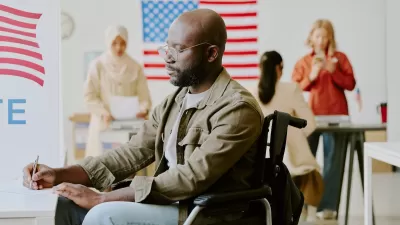Two class action lawsuits take New York’s inaccessible metro system to task.

According to state and federal lawsuits filed April 20, New York's Metropolitan Transportation Authority's lack of elevators and poor maintenance practices constitute discrimination against people with disabilities.
"More than 75 percent of the city’s 472 subway stations have no elevators, lifts or other alternatives to stairs," giving the MTA the lowest accessibility rate of the 10 largest transit systems in the country, according to the New York Times.
The plaintiffs, represented by Disability Rights Advocates, want the court to require the MTA to change the way it deals with elevator maintenance and to develop a long-term plan to improve the system's accessibility.
In March, the Times ran a feature on how the state of the subway system impacts disabled residents, sometimes shutting them out of public life. One plaintiff who uses a wheelchair said, "Because of the lack of elevators, my disability really comes to the forefront in terms of what activities I can engage in, in the city."
He takes a different subway line uptown after work in order to catch another line back to Brooklyn to reach a station with an elevator for southbound commuters. He said he regularly cancels social engagements if he finds there is no viable way to travel to a station with a working elevator. And he has counted more than 200 elevator failures in the last two and a half years — about one for every eight trips he takes, he said.
An MTA spokesperson said the agency is spending $1 billion to bring 25 more stations into compliance with the ADA, and estimated it would take $10 billion to complete the rest.
FULL STORY: New York City’s Subway System Violates Local and Federal Laws, Disability Groups Say

Alabama: Trump Terminates Settlements for Black Communities Harmed By Raw Sewage
Trump deemed the landmark civil rights agreement “illegal DEI and environmental justice policy.”

Planetizen Federal Action Tracker
A weekly monitor of how Trump’s orders and actions are impacting planners and planning in America.

The 120 Year Old Tiny Home Villages That Sheltered San Francisco’s Earthquake Refugees
More than a century ago, San Francisco mobilized to house thousands of residents displaced by the 1906 earthquake. Could their strategy offer a model for the present?

Ken Jennings Launches Transit Web Series
The Jeopardy champ wants you to ride public transit.

BLM To Rescind Public Lands Rule
The change will downgrade conservation, once again putting federal land at risk for mining and other extractive uses.

Indy Neighborhood Group Builds Temporary Multi-Use Path
Community members, aided in part by funding from the city, repurposed a vehicle lane to create a protected bike and pedestrian path for the summer season.
Urban Design for Planners 1: Software Tools
This six-course series explores essential urban design concepts using open source software and equips planners with the tools they need to participate fully in the urban design process.
Planning for Universal Design
Learn the tools for implementing Universal Design in planning regulations.
Clanton & Associates, Inc.
Jessamine County Fiscal Court
Institute for Housing and Urban Development Studies (IHS)
City of Grandview
Harvard GSD Executive Education
Toledo-Lucas County Plan Commissions
Salt Lake City
NYU Wagner Graduate School of Public Service





























